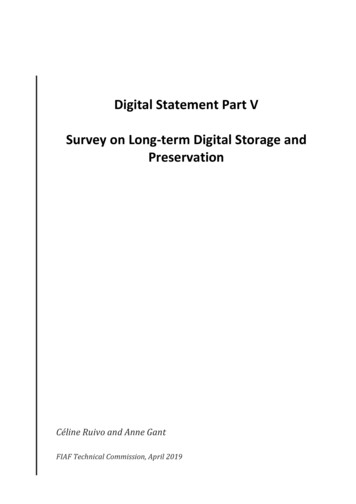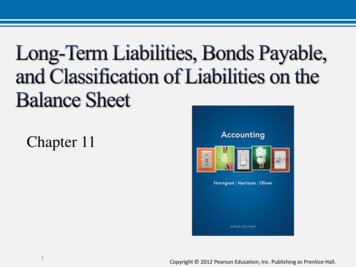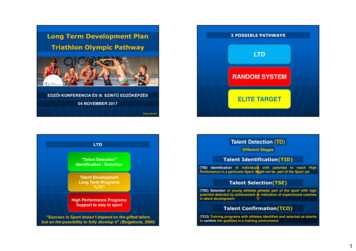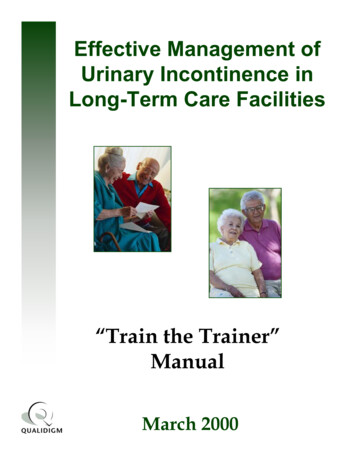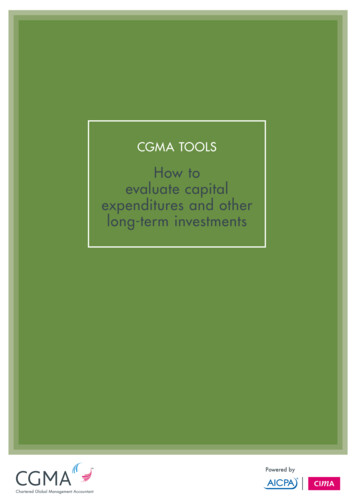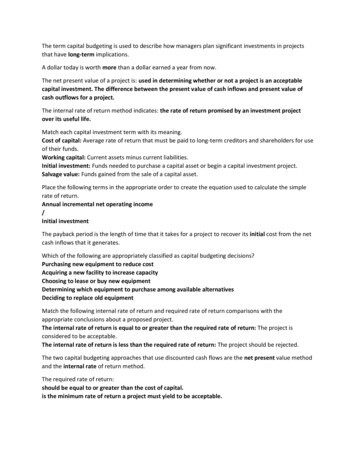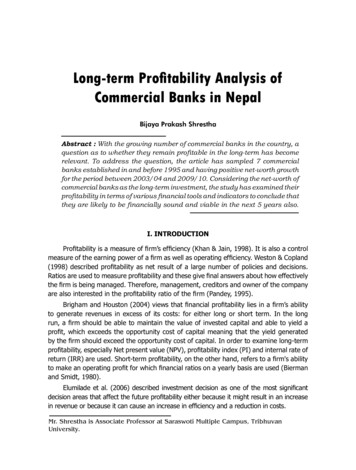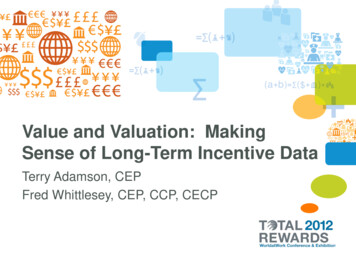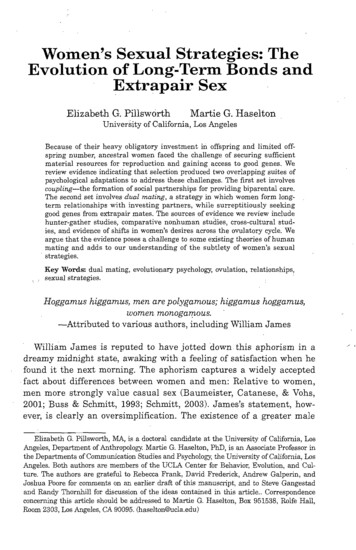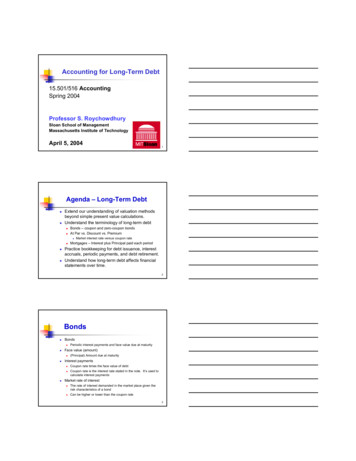
Transcription
Accounting for Long-Term Debt15.501/516 AccountingSpring 2004Professor S. RoychowdhurySloan School of ManagementMassachusetts Institute of TechnologyApril 5, 20041Agenda – Long-Term Debt Extend our understanding of valuation methodsbeyond simple present value calculations.Understand the terminology of long-term debt Bonds – coupon and zero-coupon bondsAt Par vs. Discount vs. Premium Mortgages – Interest plus Principal paid each period Market interest rate versus coupon ratePractice bookkeeping for debt issuance, interestaccruals, periodic payments, and debt retirement.Understand how long-term debt affects financialstatements over time.2Bonds Bonds Face value (amount) Interest payments Periodic interest payments and face value due at maturity(Principal) Amount due at maturityCoupon rate times the face value of debtCoupon rate is the interest rate stated in the note. It’s used tocalculate interest paymentsMarket rate of interest The rate of interest demanded in the market place given therisk characteristics of a bondCan be higher or lower than the coupon rate3
Bonds Consider a loan with principal of 10,000 initiated on 1/1/01 The market interest rate is 6% Final payment is to be made at the end of the third year, i.e., on12/31/03.What annual payments are required under the following threealternatives? Annual interest payment at the end of each year and repaymentof principal at the end of the third year (typical bond terms).A single payment (of principal and interest) at the end of year 3(Zero-Coupon bond).Three equal payments at the end of each year (mortgage / newcar loan terms).4Bonds - alternative paymentstreamsCouponZeroMortgageEnd of Year 1Int0Int PEnd of Year 2Int0Int PEnd of Year 3Int PInt PInt P5Accounting for a Bond issued at parCoupon Rate 6% Market Rate 6% At the time of the bond issue 10,00010,000Periodically thereafter Dr CashCr Bond PayableCash interest payments Face Value x Coupon rateBond payable at the present value of cash flows, i.e., the presentvalue of interest and principalInterest expense Bond payable x market interest rateDifference between interest expense and cash interest payment isadded to Bond PayableAt maturity Pay interest and entire principal balance6
Accounting for a Bond issued at parCoupon Rate 6% Market Rate 6% What is the present value of the bond?Payment stream Three annual coupon payments of 600 eachPrincipal payment of 10,000 at the end of three yearsPresent value PV of ordinary annuity, n 3, r 6%, Table 4 600 x 2.67301 1603.81PV of 10,000, n 3, r 6%, Table 2 10,000 x 0.83962 8396.20PV 1603.81 8396.20 10,0007Accounting for a Bond issued at parCoupon Rate 6% Market Rate 6% End of year 1 Dr Interest expenseCr Cash600600End of year 2 Interest expense 10,000 x 6%Coupon payment 100,000 x 6%Dr Interest expenseCr Cash600600End of year 3 Dr Interest expenseCr CashDr Bond PayableCr Cash60060010,00010,0008Accounting for a Bond issued at parCoupon Rate 6% Market Rate 6%IssuanceCash10,000Cash Bond Payable10,000Bond Payable Ret Erngs2001(600) (600)2002(600) (600)2003(600)(10,000) (600)(10,000)9
Accounting for a ZeroCoupon BondThe zero-coupon bond pays 10,000 at the end ofthree years.How much will it sell for? That is, how much cashproceed will the firm receive at the time of issuingthe zero-coupon bond? What is the present value of such a bond at the time ofissue?PV of 10,000, n 3, r 6%, Table 2 10,000 x 0.83962 8396.2010Accounting for a ZeroCoupon BondAt the time of the bond issue Dr CashDr Discount on bonds payableCr Bond Payable8,396.201,603.8010,000.00Balance sheet presentation Bond payable, grossLess DiscountNet Bond Payable 10,000.00( 1603.80) 8396.2011Zero-Coupon Bond Over time, the discount is reduced so that at maturity the netbond payable equals the face value of the bonds, 10,000Periodically after issuance Cash interest payments 0Interest expense Bond payable x market interest rateDifference between interest expense and cash interest paymentreduces Discount AccountAt maturity Pay interest and entire principal balanceRemove Bonds Payable12
Zero-Coupon Bond End of year 1 Interest expense 8,396.2 x 6% 503.77No cash interest payment, so add the interest to BondPayableDr Interest expense503.77Cr Discount503.77Balance in Discount Account (1603.80 – 503.77) 1100.03Net Bonds Payable 8396.20 503.77 8899.97ORNet Bonds Payable 10,000 – (1100.03) 8899.9713Zero-Coupon Bond End of year 2 Interest expense 8,899.97 x 6% 534.00No cash interest payment, so add the interest to BondPayableDr Interest expense534.00Cr Discount534.00Balance in Discount Account (1100.03 – 534.00) 566.03Net Bonds Payable 8899.97 534.00 9433.97ORNet Bonds Payable 10,000 – 566.03 9433.9714Zero-Coupon Bond End of year 3 Interest expense 9433.97 x 6% 566.03No cash interest payment, so add the interest to Bond Payable Dr Interest expenseCr Discount Balance in Discount Account 0 566.03566.03Net Bonds Payable 9433.97 566.04 10,000ORNet Bonds Payable 10,000 – 0 10,000Pay off the bond at maturityDr Bond Payable10,000Cr Cash10,00015
Accounting for a Zero-Coupon BondCashIssue 8,396.20Cash02001EB2002EB02003EB0 [Bond Payable – Discount ] NBP[ 10,000- 1,603.80 ] 8,396.20[Bond Payable - Discount ]503.7710,000- 1,100.03 10,000- 10,000NBP 0(566.03)Pay off the bond(10,000)(10,000)16Accounting for a Mortgage In a mortgage, you make equal payments eachperiod until maturity.Each payment represents interest and someprincipal repayment.PV of an ordinary annuity of three payments 10,000 N 3, r 6%, Table 4 10,000 PVOA (n 3, r 6%) x Mortgage PaymentMortgage Payment 10,000/2.67301 3741.1017Accounting for a Bond issued at parCoupon Rate 6% Market Rate 6% At the time of the mortgage Dr CashCr Mortgage Payable10,00010,000Periodically thereafter until maturity Cash mortgage payment equals Interest expense Outstanding mortgage balance x Marketinterest rateThe excess of mortgage payment over interest expensereduces the Mortgage Principal balance18
Accounting for a MortgageCashSigning 10,000 Mortgage Payable10,000Cash Mortgage Ret Earnings2001EB01(3,741) (3,141)6,859(600)2002EB02(3,741) (3,329)3,530(412)2003EB03(3,741) (3,530)0(211)19Bond issued at a DiscountCoupon rate 6% Market rate at issuance 8% Cash flows to the bondholder Interest payments Coupon rate x Face Value 600Principal at maturity 10,000Proceeds from bond issue PV of cash flows discounted at the MARKET interest rate of 8%PVOA (n 3, r 8%) x 600 2.57710 x 600 1546.26PV of (10,000, n 3, r 8%) 0.79383 x 10,000 7938.30Total 9484.56Bond PayableLess DiscountNet Bond Payable 10,000.00(515.44) 09,484.5620Bond issued at a DiscountCoupon rate 6% Market rate at issuance 8% At the end of first yearInterest expense Net Bond Payable x 8% 9484.56 x 8% 758.77Dr Interest expense758.77Cr CashCr Discount on Bond Payable Net Bond Payable 9484.56 158.77 9643.33 600.00158.7721
Bond issued at a DiscountCoupon rate 6% Market rate at issuance 8%IssueCash9,485 Cash [Bond Payable – Discount ] NBP[ 10,000- 515 ] 9,485[Bond Payable - Discount ]NBP 9,643RE2001 (600) 1592002 (600) 1719,815(759)(771)2003 (600) (10,000)18510,000(10,000)(785)22Bond issued at a PremiumCoupon rate 6% Market rate at issuance 4%IssueCash10,555 [Bond Payable Premium ][ 10,000 555 ][Bond Payable Premium ]NBP10,555Cash 2001 (600) (178)10,377NBP (422)RE2002 (600) (185)10,192(415)2003 (600) (10,000)(192)10,000(10,000)(408)23Bonds - disclosures Balance sheet Current portion of L-T debt in current liabilitiesLong-term debt Income Statement Indirect SCF Interest expenseOperations - interest accruals not yet paid, amortization ofdiscount/premiumInvesting - purchase / sale of available for sale debtFinancing - proceeds, repayment supplemental disclosure ofcash paid for interestNotes Details on all of the above24
Bond DisclosuresUAL, 1997(8) Long-Term DebtA summary of long-term debt, including current maturities, as of December 31is as follows (interest rates are as of December 31, 1997):(In Millions)1997----Secured notes, 6.13% to 8.90%,averaging 7.16%, due through 2014Debentures, 9.00% to 11.21%, averaging9.97%, due through 2021Convertible debentures, 7.75%, due 2010Promissory notes, 6.33% to 11.00%,averaging 6.51%, due through 2000Special facility bonds, 5.625%, due 2034Less: Unamortized discount on debtCurrent maturities1996---- 1,295 78570190---------2,340----(13)(235)---- 2,092 8199361664-1,835----(9)(165)---- 1,661 25Courtesy of U.S. Securities and Exchange Commission. Used with permission.Does the Balance Sheet Representthe Market Value of Debt?Shoney’s, 1999Subordinated zero-coupondebentures, due April 20041999 122,520,7121998 112,580,014What is the effective interest rate Shoney has used?Zero coupon bond valuet valuet-1 (1 r) r 122,520,712 / 112,580,014 – 1 8.83%What is the market interest rate of the debt? The Wall StreetJournal reported in 1999 that Shoney’s debt was selling for 210 perthousand, with 5 years until maturity.FVn PV0 (1 r)n1000 210 (1 r)5 (1000/210)1/5 – 1 36.6%26Shoney's Statement of Cash Flows:Effect of Discount AmortizationYears EndedOctober 31October 2519991998Operating activities (28,826,398) (107,703,920)Net lossAdjustments to reconcile net loss to netcash provided by operating activities:Depreciation and amortization41,162,15549,340,252Interest expense on zero couponconvertible debentures and other noncashcharges16,329,93218,508,713Deferred income taxes(1,890,000) 38,088,000Gain on disposal of property, plant andequipment(20,230,756) (9,417,828)Impairment of long-lived assets18,424,04648,403,158Changes in operating assets and liabilities:Notes and accounts 236,546Prepaid expenses(1,676,202)1,450,081Accounts payable(10,850,662)2,524,508Deferred income and other ------Net cash provided by operating activities34,521,04655,063,923The annual discount amortizationon the zeros (which is equal tothe annual interest expense on thezeros) is a non-cash expense andis added back to NI to reconcile toOCF.27Courtesy of U.S. Securities and Exchange Commission. Used with permission.
Early Retirement of DebtYou repurchase Zero-Coupon bonds (Face Value 11,910) in theopen market at the start of 2002 (2 years to maturity) when the marketrate is 5%. The market rate of interest at time of issue was 6%.What is the market price of the bonds at that time?PV0PV0 FVn / (1 r)n 11,910 / (1.05)2 10,803What is the effect on the BSE and financial statements?Cash (A) Bond Principal - Discount REBB11,9101,310(10,803)(11,910)(1,310)(203)The gain or loss on early retirement of debt is reported as anextraordinary item on the income statement.What is the journal entry?28Bonds - debt covenants (TCBY) Borrower will at all times maintain a ratio of Current Assets to Current Liabilities that is greater than2.0 a Profitability ratio greater than 1.5 [defined as] the ratio of NetIncome for the immediately preceding period of 12 calendar monthsto Current Maturities of Long Tern Debt a Fixed Coverage Ratio greater than 1.0 [defined as] the ratio ofNet Income plus noncash Charges to Current Maturities of LongTerm Debt . plus cash dividends plus Replacement CapEx ofthe Borrower[Borrower will not] sell, lease, transfer, or otherwise dispose ofany assets except for the sale of inventory and dispositionof obsolete equipment [to] repurchase the stock of TCBY[Borrower agrees it will not take on new loans if] the aggregateamount of all such loans would exceed 25% of theconsolidated Tangible Net Worth of the Borrower.29
Balance sheet presentation Bond payable, gross 10,000.00 Less Discount ( 1603.80) Net Bond Payable 8396.20 11 Zero-Coupon Bond Over time, the discount is reduced so that at maturity the net bond payable equals the face value of the bonds, 10,000 Periodically after issuance Cash interest payments 0 Interest expense Bond payable x market interest rate Difference between interest
